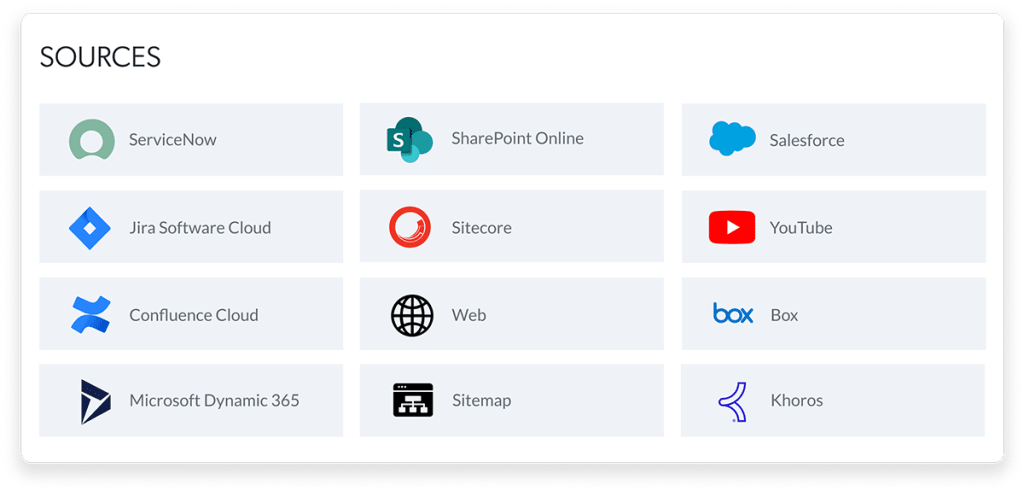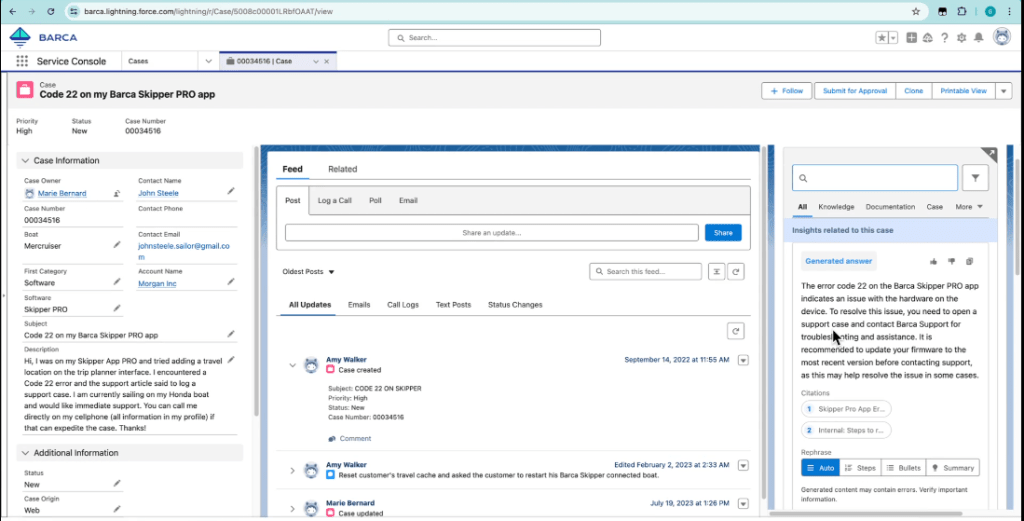I still remember the day I hit a wall — not in my personal life, but as a customer. I was trying to solve a simple issue on a support portal. I typed into the search bar — like 43% of users do — and got a list of irrelevant, outdated results. Tried again. Still no luck. I gave up and opened a ticket.
That moment stuck with me because I knew the cost. Not just to me as a user, but to the business behind that experience: escalated cases. Higher cost to serve. Plummeting CSAT. And it all boiled down to one root cause: broken self-service.
Despite the best tech investments, only 14% of customer issues are resolved via self-service. Why? Ask any CX or support leader, and you’ll hear the same answer: silos. Content silos. Data silos. Team silos. In fact, 70% of CX leaders say these silos are their biggest service roadblock.
And as VPs of Support, we know — if customers can’t find answers, they file cases. And when agents can’t find answers either, tickets pile up. The friction multiplies. That’s the true cost of silos.
What Is the Silo Problem?
Organizational silos may seem like an intangible undercurrent, but they indicate real and ongoing disconnect. Silos happen when teams, departments, or entire business units work independently of each other, at times inhibiting work that requires cross functional collaboration.
According to McKinsey, the symptoms of silo dysfunction are easy to spot: poor information flow, lack of coordination, and fuzzy accountability — especially across initiatives like customer experience that span multiple teams. And the consequences? Slower decisions. Less agility. More missed opportunities.

It’s not just an operational headache — it’s a growth killer. McKinsey found that companies with fewer silos outperform their peers by nearly 3x in total returns to shareholders. That’s not a rounding error. That’s a wake-up call.
Core to the silo problem is how each business unit goes it alone. Many rely on different systems, tools, and data sources to resolve their own individual problems. This gives way to the silo mentality, in which these groups don’t engage in knowledge sharing at all.
Let’s take a closer look at specific examples of silos that can appear in customer service.
Examples of team silos in customer service
- Sales vs. support
Scenario: Customer makes a purchase based on promised features made during the sales cycle, only to find that support has no record or feature documentation. - Tier 1 vs. technical support
Scenario: A customer is transferred to a different support tier that doesn’t have access to detailed notes from previous support interactions. - Technical support vs. knowledge base team
Scenario: A technical writer needs to document an advanced workaround, but that knowledge lives in an SME’s head, who’s too busy or unwilling to share it. - Channel silos
Scenario: A customer complaint on social media is handled separately from a related (and ongoing) email support ticket, leading to duplicated efforts. - Customer service vs. product/engineering:
Scenario: Customer service logs a frequently reported bug, but product/engineering miss it in the absence of an efficient feedback loop. - Loyalty vs. retention:
Scenario: A customer threatens to cancel service; the agent resolves the immediate issue, but lacks system access to offer a loyalty incentive or escalate to the retention team, leading to churn.
And this is just in customer service — the silo problem can extend across the entire organization.
When these organizational dynamics dominate, it’s no wonder that 84% of customers feel they put in significant effort to find information. Or that 47% of employees say the information they need is stored across multiple applications.
According to TSIA, creating knowledge silos has ripple effects: 71% of companies use six or more tools/systems. The customer service representatives in those companies navigate 17 disparate knowledge sources, on average, during their daily work.
Not ideal for delivering a connected omnichannel experience.
Why Fixing the Silo Problem Is So Difficult
As individual teams roll out platforms and processes, the problem accrues. Call it the silo effect, in which the proliferation of different silos compounds the ripple effects, causing friction or outright breakdowns across the customer service journey.
Enterprises with many silos tend to maintain disjointed search experiences (or separate search indices altogether) for their website, customer portal, employee intranet, and knowledge base. Underlying these self-service touchpoints are different platforms and collaboration tools, each storing its own content.

In other words, disconnected systems and scattered content.
The Informatica case study embodies this scenario. Before transforming their digital experience, Informatica’s support engineers were spending up to 20% of their work time searching for information. Why? What they were looking for resided in 25 content sources and 40+ languages.
For other companies in this situation, data migration is an option. But migrating siloed data can be costly and difficult. One study on data migration costs observed migration projects that could last anywhere from 3-24 months, with costs ranging from $100,000 to multiple millions.
The more scalable cure for silo thinking? Unified AI search.
4 Ways Unified AI Search Breaks Down Silos
AI search may be more viable than outright data migration, with one caveat: service and technology leaders who go this route need the ability to scale. They need to turn successful AI search use cases into unified, enterprise-wide search experiences. Only then can they effectively overcome the silo mindset.
Here are four indicators that an enterprise search solution is both intelligent and scalable:
1. Search connectors
Most enterprise search solutions offer myriad search connectors that stitch each data silo into a federated experience.
But more important than the quantity of search connectors is the quality. Quality search connectors deliver better performance. You’ll recognize them based on five characteristics:
- Simple and efficient setup to limit implementation time, cost, and errors
- Refresh, rescan, rebuild functionality that can be tailored to specific needs
- Airtight security for data accessed and transferred via connector
- Flexible indexing that only takes necessary, relevant data
- Native and universal connectors for better adaptability to different platforms

Relevant reading: Achieve Enterprise Connectivity Without Costly Migration
2. Bonafide unified search
The silo problem will persist unless the enterprise can centralize access to every information silo (websites, file shares, etc.).
But true unified search depends on more than the quality of connectors it offers. It has to:
- Offer a single unified index, not just a federation of multiple existing indices
- Be optimized for hybrid search ranking, which combines combines lexical, vector-based, and AI-powered techniques
- Enforce early binding security, meaning indexing permissions at the document level (instead of at the time of query)
- Support more efficient retrieval, while allowing content owners to retain ownership
- Surface information anywhere, especially to answer customer questions

This degree of unified index was central to the SAP Concur case study. It’s what allowed the global tech leader to bring together millions of knowledge assets, some as much as two decades old, into a single self-service experience for its customers. And now that customers can find information on their own, SAP Concur is saving $8.6 million in annual cost-to-serve.
3. A generative AI search layer
With a true unified index as its prerequisite, generative search introduces a conversational dynamic to search experiences. See how United Airlines uses Coveo Relevance Generative Answering to perform two important jobs:
- Synthesize search results so customers get what they need without having to click
- Recognize typos or incorrectly phrased queries and avoid hallucinations

A similar story for the F5 Networks case study. After unifying 20 customer-facing websites to create “a ridiculously easy F5 experience,” the F5 team used Coveo to layer generative answering on top of search, further enhancing the quality of results and engagement as shown in their 11% improvement in self-service success with generative AI.
4. Agent assist
While it’s natural to want most if not all customer questions resolved via self-service, the reality is that human customer service representatives will still be needed for complex problems. Personalized, human agent assistance can be a differentiator for companies competing in a digital landscape; there are also opportunities to monetize personalized, human assistance.
When a customer falls through to assisted support, unified search gives support agents the same intuitive search experience that customers receive. It can also equip them proactively, as with Coveo Insight Panels for agent assist.

Agent assist integrates two AI-powered capabilities that empower agents:
Resolve on contact: Equip agents to begin resolving issues immediately upon contact. With Coveo AI proactively reading incoming chats, cases, and messages, relevant content is already waiting for agents when the case arrives. This allows agents to focus on connecting with the customer rather than wasting time searching for the right knowledge.
AI response generation: Generative answering can provide agents with ready-to-use answers that would normally take them several minutes to compose themselves, drastically speeding up resolution times.
As agent assist shows, the compounding consequences of knowledge silos can be turned into compounding wins. For example, the Coveo AI-Platform for Genesys Cloud can reduce handle times up to 30%. That’s great for agent collaboration and productivity, even better for customer experience.
Relevant reading: Learn more about Coveo for Contact Center AI & Agent Assist
Fix the Silo Problem for Good
We can share case study after case study that all begin the same way:
- Too many distinct data sources
- Too many isolated tools and platforms
- A lack of unified vision and communication
- Overburdened support teams and disjointed CX
In case study after case study, this silo problem has deepened, evolved, and persisted over years, making the path to transformation seem prohibitively complex. That is, until these enterprises adopted a unified search search experience, powered by AI.

Unified search breaks down organizational silos by connecting all data sources and content toward a common goal:
Building cohesive customer service journeys.
This critical step opens the door to personalized, AI-driven experiences across the customer journey. We touched briefly on how United Airlines and F5 leverage generative search. Watch 5 AI Use Cases for a Connected Customer Journey for more ways to bring relevance to other high-value touchpoints.
Dig Deeper
Looking for reliable ways to evaluate search platforms for your enterprise? Read our Buyer’s Guide for Best Enterprise Search Engine to make sure your solution has what it takes to break down organizational siloes.


